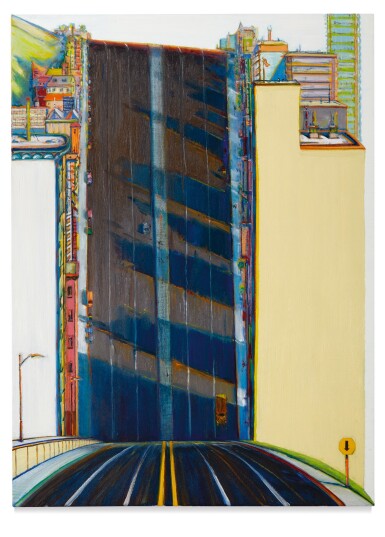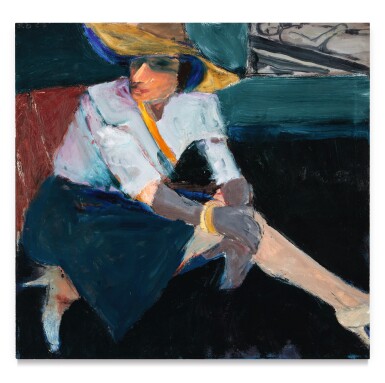American Visionary: The Collection of Mrs. John L. MarionJuan de EspinosaMadrid circa 1605 or 1610 - 1671 ZaragozaStill life with a Tonalá earthenware vessel
oil on canvascanvas: 31½ by 24 in.; 80 by 61 cm. framed: 36¾ by 29 in.; 93.5 by 73.7 cm. Condition reportThe following condition report has been provided by Simon Parkes of Simon Parkes Art Conservation, Inc. 502 East 74th St. New York, NY 212-734-3920, simonparkes@msn.com, an independent restorer who is not an employee of Sotheby's. This work is generally in very good condition. The canvas has an old lining which is still stabilizing the paint layer. The surface has an attractive texture. The paint layer is clean and varnished. Retouches are clearly visible under ultraviolet light, mainly to small cracks in the lighter colors and slight weakness to the brown background around the elements of the still life throughout. There are some scuffs to the varnish around the edges which could easily be corrected, but the work should otherwise be hung in its current state.
The lot is sold in the condition it is in at the time of sale. The condition report is provided to assist you with assessing the condition of the lot and is for guidance only. Any reference to condition in the condition report for the lot does not amount to a full description of condition. The images of the lot form part of the condition report for the lot. Certain images of the lot provided online may not accurately reflect the actual condition of the lot. In particular, the online images may represent colors and shades which are different to the lot's actual color and shades. The condition report for the lot may make reference to particular imperfections of the lot but you should note that the lot may have other faults not expressly referred to in the condition report for the lot or shown in the online images of the lot. The condition report may not refer to all faults, restoration, alteration or adaptation. The condition report is a statement of opinion only. For that reason, the condition report is not an alternative to taking your own professional advice regarding the condition of the lot. NOTWITHSTANDING THIS ONLINE CONDITION REPORT OR ANY DISCUSSIONS CONCERNING A LOT, ALL LOTS ARE OFFERED AND SOLD "AS IS" IN ACCORDANCE WITH THE CONDITIONS OF SALE/BUSINESS APPLICABLE TO THE RESPECTIVE SALE.ProvenanceAnonymous sale, Lyon, Jean Claude Anaf, 8 February 1998, lot 152;
Where acquired by Caylus, Madrid, and Rafael Valls Ltd., London;
With Mitchell-Innes & Nash, New York;
From whom acquired, March 2006.LiteratureP. Cherry, Arte y Naturaleza, El Bodegón Español en el Siglo de Oro, Madrid 1999, p. 210, cat. no. 1, reproduced fig. LVII.ExhibitedBurgos, Monasterio de San Juan, El Jardin de Melibea, 18 April - 20 June 2000, no. 124;
London, Rafael Valls Ltd.; Madrid, Caylus, Naturaleza Muertas Espanolas de los siglos XVII a XIX, 1 December 2003 - 13 February 2004, no. 14. Catalogue noteJuan de Espinosa, a still-life specialist, produced this composition in mid-seventeenth century Madrid. Little is known about Espinosa's career—his oeuvre is based on three signed paintings, two in the Museo del Prado (inv. nos. P007924, P0007021) and one in the Musée du Louvre (inv. no. RF 1973 2).2 But his technical virtuosity, evident in the variety of colors and textures, is apparent. In particular, the grapes, a motif considered a hallmark of Espinosa's paintings, are rendered with great skill: their translucent skins glisten as they catch the light. In the catalogue for the 1998 sale (see Provenance), Bill Jordan confirmed the attribution of the present work.
The elaborate earthenware vessel depicted in this painting was produced by an indigenous artist working in Tonalá, Mexico. The city's ceramics tradition predates the Hispanic period, when the area was part of the viceroyalty of New Spain, but during the sixteenth century, Europeans became fascinated with the unique qualities of the region's clay and imported pieces across the Atlantic. In Europe such ceramic vessels were called "búcaros de Indias," or Indian vases, and were highly prized for their superb craftsmanship, New World origin, and fragrant clay. The fountain's water, infused with the clay's aroma, would have diffused a pleasing scent.
Tonalá ceramics appear in paintings produced by some of the seventeenth-century's most celebrated artists, among them Antonio Pereda, Antonio Ponce Juan van der Hamen y León and Diego Velázquez Indeed, the infanta Margarita holds a small búcaro on a silver tray in Las Meninas. Here, the fascinating object reflects the globalized aesthetic facilitated by the fluid exchange of artistic ideas between Europe and Latin America, but also offers a striking visualization of the indigenous labor that underpinned the colonial enterprise.
1 The signature, recorded in the nineteenth century, is no longer visible on the latter.2 Espinosa has sometimes been confused with the painter Juan Bautista de Espinosa (circa 1585-1640), largely a painter of altarpieces.
American Visionary: The Collection of Mrs. John L. MarionJuan de EspinosaMadrid circa 1605 or 1610 - 1671 ZaragozaStill life with a Tonalá earthenware vessel
oil on canvascanvas: 31½ by 24 in.; 80 by 61 cm. framed: 36¾ by 29 in.; 93.5 by 73.7 cm. Condition reportThe following condition report has been provided by Simon Parkes of Simon Parkes Art Conservation, Inc. 502 East 74th St. New York, NY 212-734-3920, simonparkes@msn.com, an independent restorer who is not an employee of Sotheby's. This work is generally in very good condition. The canvas has an old lining which is still stabilizing the paint layer. The surface has an attractive texture. The paint layer is clean and varnished. Retouches are clearly visible under ultraviolet light, mainly to small cracks in the lighter colors and slight weakness to the brown background around the elements of the still life throughout. There are some scuffs to the varnish around the edges which could easily be corrected, but the work should otherwise be hung in its current state.
The lot is sold in the condition it is in at the time of sale. The condition report is provided to assist you with assessing the condition of the lot and is for guidance only. Any reference to condition in the condition report for the lot does not amount to a full description of condition. The images of the lot form part of the condition report for the lot. Certain images of the lot provided online may not accurately reflect the actual condition of the lot. In particular, the online images may represent colors and shades which are different to the lot's actual color and shades. The condition report for the lot may make reference to particular imperfections of the lot but you should note that the lot may have other faults not expressly referred to in the condition report for the lot or shown in the online images of the lot. The condition report may not refer to all faults, restoration, alteration or adaptation. The condition report is a statement of opinion only. For that reason, the condition report is not an alternative to taking your own professional advice regarding the condition of the lot. NOTWITHSTANDING THIS ONLINE CONDITION REPORT OR ANY DISCUSSIONS CONCERNING A LOT, ALL LOTS ARE OFFERED AND SOLD "AS IS" IN ACCORDANCE WITH THE CONDITIONS OF SALE/BUSINESS APPLICABLE TO THE RESPECTIVE SALE.ProvenanceAnonymous sale, Lyon, Jean Claude Anaf, 8 February 1998, lot 152;
Where acquired by Caylus, Madrid, and Rafael Valls Ltd., London;
With Mitchell-Innes & Nash, New York;
From whom acquired, March 2006.LiteratureP. Cherry, Arte y Naturaleza, El Bodegón Español en el Siglo de Oro, Madrid 1999, p. 210, cat. no. 1, reproduced fig. LVII.ExhibitedBurgos, Monasterio de San Juan, El Jardin de Melibea, 18 April - 20 June 2000, no. 124;
London, Rafael Valls Ltd.; Madrid, Caylus, Naturaleza Muertas Espanolas de los siglos XVII a XIX, 1 December 2003 - 13 February 2004, no. 14. Catalogue noteJuan de Espinosa, a still-life specialist, produced this composition in mid-seventeenth century Madrid. Little is known about Espinosa's career—his oeuvre is based on three signed paintings, two in the Museo del Prado (inv. nos. P007924, P0007021) and one in the Musée du Louvre (inv. no. RF 1973 2).2 But his technical virtuosity, evident in the variety of colors and textures, is apparent. In particular, the grapes, a motif considered a hallmark of Espinosa's paintings, are rendered with great skill: their translucent skins glisten as they catch the light. In the catalogue for the 1998 sale (see Provenance), Bill Jordan confirmed the attribution of the present work.
The elaborate earthenware vessel depicted in this painting was produced by an indigenous artist working in Tonalá, Mexico. The city's ceramics tradition predates the Hispanic period, when the area was part of the viceroyalty of New Spain, but during the sixteenth century, Europeans became fascinated with the unique qualities of the region's clay and imported pieces across the Atlantic. In Europe such ceramic vessels were called "búcaros de Indias," or Indian vases, and were highly prized for their superb craftsmanship, New World origin, and fragrant clay. The fountain's water, infused with the clay's aroma, would have diffused a pleasing scent.
Tonalá ceramics appear in paintings produced by some of the seventeenth-century's most celebrated artists, among them Antonio Pereda, Antonio Ponce Juan van der Hamen y León and Diego Velázquez Indeed, the infanta Margarita holds a small búcaro on a silver tray in Las Meninas. Here, the fascinating object reflects the globalized aesthetic facilitated by the fluid exchange of artistic ideas between Europe and Latin America, but also offers a striking visualization of the indigenous labor that underpinned the colonial enterprise.
1 The signature, recorded in the nineteenth century, is no longer visible on the latter.2 Espinosa has sometimes been confused with the painter Juan Bautista de Espinosa (circa 1585-1640), largely a painter of altarpieces.




.jpg?w=400?width=1600&quality=70)










Try LotSearch and its premium features for 7 days - without any costs!
Be notified automatically about new items in upcoming auctions.
Create an alert